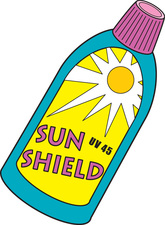
It’s that time of year again. The days are getting longer, the air is warmer, baseball teams are back on the field, and the sun is shining—yes my friends, it is almost summer vacation. Summer—it’s the time for relaxation, outdoor activities, time with friends, and some sweating. But, there is a harsh reality that we need to keep in mind. 42% of people get sunburned at least once a year. I know what you’re thinking: rub some aloe on it, you’ll be fine. But do you really know what happens to your skin when it gets too much sun?
A person's risk for melanoma—the most serious form of skin cancer—doubles if he or she has had five or more sunburns. I am not saying five or more sunburns in one year, no I mean in a lifetime. Research shows that one sunburn can cause long-lasting damage to the skin.
Three different types of skin cancers are related to sunburn. The two most common nonmelanoma skin cancers, basal cell carcinoma and squamous cell carcinoma, are directly correlated with sun accumulation over many years. The most common locations for basal cell carcinoma and squamous cell carcinoma tumors are sun-exposed areas: the face, ears, and hands. Melanoma is different. The sun exposure pattern believed to result in melanoma is that of brief, intense exposure –a blistering sunburn—rather than years of tanning.
So what’s to learn from this? Your mom was right; it’s great to play outside, but put on sunblock!
Here are some helpful tips to stay sunburn free this summer:
A person's risk for melanoma—the most serious form of skin cancer—doubles if he or she has had five or more sunburns. I am not saying five or more sunburns in one year, no I mean in a lifetime. Research shows that one sunburn can cause long-lasting damage to the skin.
Three different types of skin cancers are related to sunburn. The two most common nonmelanoma skin cancers, basal cell carcinoma and squamous cell carcinoma, are directly correlated with sun accumulation over many years. The most common locations for basal cell carcinoma and squamous cell carcinoma tumors are sun-exposed areas: the face, ears, and hands. Melanoma is different. The sun exposure pattern believed to result in melanoma is that of brief, intense exposure –a blistering sunburn—rather than years of tanning.
So what’s to learn from this? Your mom was right; it’s great to play outside, but put on sunblock!
Here are some helpful tips to stay sunburn free this summer:
- Seek the shade, especially between 10 A.M. and 4 P.M.
- Do not burn.
- Avoid tanning and UV tanning booths.
- Use a sunscreen with an SPF of 15 or higher every day.
- Apply 1 ounce (2 tablespoons) of sunscreen to your entire body 30 minutes before going outside. Reapply every two hours.
- Cover up with clothing, including a broad-brimmed hat and UV-blocking sunglasses.
- Keep newborns out of the sun. Sunscreens should be used on babies over the age of six months.
- Examine your skin head-to-toe every month.
- See your physician every year for a professional skin exam.


 RSS Feed
RSS Feed